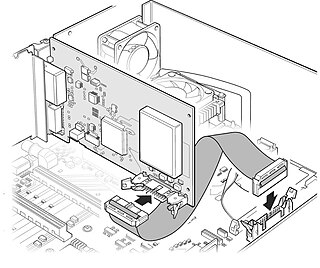Communication is the act of creating and conveying information.
Contents
Communication(s) may also refer to:
Communication is the act of creating and conveying information.
Communication(s) may also refer to:
Matrix most commonly refers to:
A signal is any variation of a medium that conveys information.
Screen or Screens may refer to:
Data communication, including data transmission and data reception, is the transfer of data, transmitted and received over a point-to-point or point-to-multipoint communication channel. Examples of such channels are copper wires, optical fibers, wireless communication using radio spectrum, storage media and computer buses. The data are represented as an electromagnetic signal, such as an electrical voltage, radiowave, microwave, or infrared signal.
Sheet music is a handwritten or printed form of musical notation that uses musical symbols to indicate the pitches, rhythms, or chords of a song or instrumental musical piece. Like its analogs – printed books or pamphlets in English, Arabic, or other languages – the medium of sheet music typically is paper. However, access to musical notation since the 1980s has included the presentation of musical notation on computer screens and the development of scorewriter computer programs that can notate a song or piece electronically, and, in some cases, "play back" the notated music using a synthesizer or virtual instruments.
Imagine may refer to:
Source may refer to:
Computer-mediated communication (CMC) is defined as any human communication that occurs through the use of two or more electronic devices. While the term has traditionally referred to those communications that occur via computer-mediated formats, it has also been applied to other forms of text-based interaction such as text messaging. Research on CMC focuses largely on the social effects of different computer-supported communication technologies. Many recent studies involve Internet-based social networking supported by social software.
Zoom may refer to:
Artemis is the ancient Greek goddess of the hunt, the wilderness, wild animals, the Moon, and chastity.
A code is a rule for converting a piece of information into another object or action, not necessarily of the same sort.
Technical writing is the writing of technical content, particularly relating to industrial and other applied sciences, with an emphasis on occupational contexts. The range of audiences for technical writing varies widely. In some cases, it is directed to people with specialized knowledge, such as experts or technicians. In other situations, technical writers help convey complex scientific or niche subjects to end users who need a basic understanding of a concept rather than a full explanation of a subject. Technical writing is the largest part of technical communication.
Digital usually refers to something using discrete digits, often binary digits.

Military communications or military signals involve all aspects of communications, or conveyance of information, by armed forces. Examples from Jane's Military Communications include text, audio, facsimile, tactical ground-based communications, naval signalling, terrestrial microwave, tropospheric scatter, satellite communications systems and equipment, surveillance and signal analysis, security, direction finding and jamming. The most urgent purposes are to communicate information to commanders and orders from them.

Technical illustration is illustration meant to visually communicate information of a technical nature. Technical illustrations can be components of technical drawings or diagrams. Technical illustrations in general aim "to generate expressive images that effectively convey certain information via the visual channel to the human observer".
The Jazz Composer's Orchestra was an American jazz group, founded by Carla Bley and Michael Mantler in 1965, to perform orchestral avant-garde jazz.
User experience design defines the experience a user would go through when interacting with a company, its services, and its products. User experience design is a user centered design approach because it considers the user's experience when using a product or platform. Research, data analysis, and test results drive design decisions in UX design rather than aesthetic preferences and opinions. Unlike user interface design, which focuses solely on the design of a computer interface, UX design encompasses all aspects of a user's perceived experience with a product or website, such as its usability, usefulness, desirability, brand perception, and overall performance. UX design is also an element of the customer experience (CX), and encompasses all aspects and stages of a customer's experience and interaction with a company.

Graphic communication as the name suggests is communication using graphic elements. These elements include symbols such as glyphs and icons, images such as drawings and photographs, and can include the passive contributions of substrate, colour and surroundings. It is the process of creating, producing, and distributing material incorporating words and images to convey data, concepts, and emotions.
Technical translation is a type of specialized translation involving the translation of documents produced by technical writers, or more specifically, texts which relate to technological subject areas or texts which deal with the practical application of scientific and technological information. While the presence of specialized terminology is a feature of technical texts, specialized terminology alone is not sufficient for classifying a text as "technical" since numerous disciplines and subjects which are not "technical" possess what can be regarded as specialized terminology. Technical translation covers the translation of many kinds of specialized texts and requires a high level of subject knowledge and mastery of the relevant terminology and writing conventions.
Cognitive infocommunications (CogInfoCom) investigates the link between the research areas of infocommunications and the cognitive sciences, as well as the various engineering applications which have emerged as the synergic combination of these sciences.